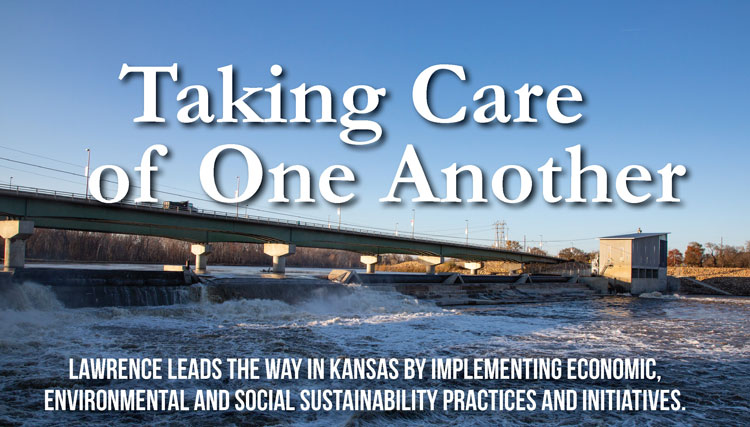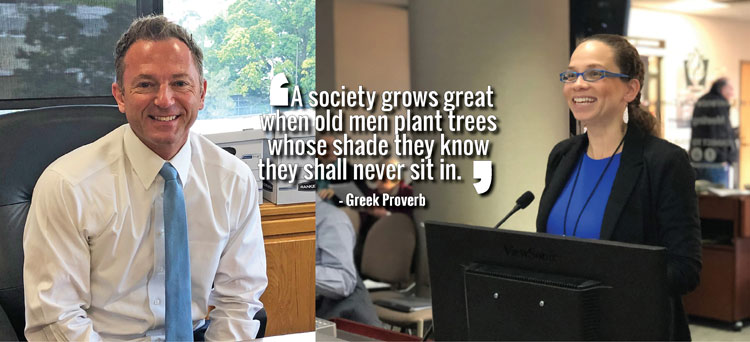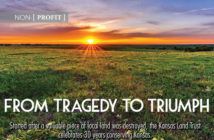Lawrence leads the way in Kansas by implementing economic, environmental and social sustainability practices and initiatives.
| 2020 Q1 | story by Bob Luder | photos by Steven Hertzog and courtesy City of Lawrence

The Kansas River
Craig Owens gazes out the large pane-glass window on the fourth floor of the north side of City Hall. He wistfully watches the water of the Kansas River below him rushing through and ponders the past as it pertains to sustainability, more specifically, renewable energy. For many decades in the past and to this day, that water produces hydroelectricity, clean energy that’s purchased by public utilities in the area.
Though Owens has only been at his job as Lawrence city manager for a few months, he says it hasn’t taken long to learn and appreciate the history and legacy of the city before him, particularly when it comes to progressive action the area has taken in sustainable practices and initiatives.
“I’ve gotten to know the history of Lawrence in these first six months,” Owens says. “It’s history that’s telling us that how we manage resources affects our success as a population.
“We’ve done things in 150-plus years as a city in different ways to accommodate our practical realities in how we’ve lived, settled and grown. History tells us people were occupying this land long before us and had ideas about how to take care of it. Now, it dawns on us that we probably haven’t minded the land as we should have.”
Across the room, Owens’ colleague, Jasmin Moore, sustainability director of Lawrence and Douglas County, sees sustainability as a prism to the future.
“Sustainability is about quality of life,” Moore says. “Not just now but into the future. It’s living today as though you believe there’s going to be a tomorrow. We feel like Lawrence is a great place to live and has a lot to offer, and we want it to be that for generations to come.”
To help ensure that, Owens, Moore and the rest of the city’s government and leadership have drawn both from past and future to come up with a plan they believe puts Lawrence at the forefront of sustainability.
And, there is evidence that shows that these plans, which have been in place a few years now, are proving effective.
In 2016, Lawrence was given a 4-STAR designation by the STAR Community Rating System, the first national certification program to recognize sustainable communities. Since the program’s launch in 2012, 51 communities nationwide have reached the 4-STAR designation, which integrates economic, environmental and social sustainability practices and initiatives. Lawrence was the first city in Kansas to receive the status.
Owens credits Eileen Horn, who preceded Moore as the city’s sustainability director and now serves in the Kansas State Legislature, for starting Lawrence’s sustainability program, which encompasses everything from energy-saving projects in city structures to implementing a cleaner-energy public transportation fleet to creating financial incentives for companies to engage in sustainable practices.

City Manager Craig Owens (L) and Jasmin Moore, Sustainability director of Lawrence and Douglas County
Sustainability’s Beginnings
Moore says the first proclamation revolving around sustainability to come out of Lawrence came in 2006. At that time, she was working in Arkansas for a metropolitan planning association and remembers sustainability becoming a buzzword sometime between 2008 and 2009.
“Grants started to become available for energy efficiency and conservation,” she says. “Communities started appointing staff to handle these funds.”
The American Recovery and Reinvestment Act of 2009 brought about even more people working in the area of sustainability, which directly resulted in the creation of the Climate Protection Plan, devised by the city later that year.
That plan included a variety of city initiatives and programs, most of which revolved around energy efficiency and renewable energy, specifically increasing energy efficiency throughout the city’s processes as well as incorporating more and more renewable energy—i.e., solar and wind. In February 2017, the city commission approved $11.3 million in a “green bond issue” for upgrades to city facilities, upgrades the city figures have saved approximately $450,000 per year in energy costs. That includes the installation of state-of-the-art light emitting diode (LED) lighting, upgrades to heating and air-conditioning equipment, and weatherization, including new roofs and windows.
One of the local beacons city leaders are most proud of is the Lawrence Public Library, which received LEED (Leadership in Energy and Environmental Design) Gold certification for its green building design and construction.
All throughout the city, there are ongoing renewable-energy projects on various buildings and infrastructure. A 100-kilowatt (kW) solar array was installed at Lawrence’s Fire Station No. 5. A 10-kW solar array is in place at Prairie Nature Center. There is a pilot project underway to demonstrate the use of solar power in a number of the city’s parking lots.
The city also has worked hard on fuel conservation and increasing the use of alternative fuel for its fleet of public vehicles. It uses hybrid buses. Other vehicles operate on compressed natural gas. Charging stations for electric vehicles are being installed around town. GPS technology is used to improve efficiencies in routes.
“Our goal is 100 percent renewables for municipal structures and eventually the whole city,” Moore says. “But, it’s going to take more than just the city to meet these goals.”
With that in mind, the city also created incentives and removed some barriers that it hopes will encourage the citizenry to take ownership in the sustainability crusade. It’s created weatherization grants for local businesses and updated building codes. In 2013, the city commission voted to reduce the building permit fees for installing solar power.
“There are plenty of businesses in Lawrence that have established leadership in sustainability,” says Moore, pointing to the example of The Merc installing shading in its parking lot.
Other Points of Pride
One of the projects that gets Moore especially excited traces back to the area’s roots as an agricultural center. The Douglas County Food Policy Council has been hard at work improving the area’s food system. From the growing of food, to harvesting, transportation, all the way to the ways waste is regenerated, the Council works on ways to make the system more efficient and better functioning.
Moore points to the Common Ground Community Garden Program, which provides small parcels of land throughout the city where citizens can grow food for themselves, their families and neighbors.
“We basically turn parkland into areas to grow food,” she says. “There’s a requirement for public benefit, which includes the donation of food, usually to schools.
“The program is in its eighth year,” Moore continues. “We have seven sites across the city today. We also have a 5-acre incubator farm.”
Owens says, “One thing I heard when I first arrived here was a phrase, ‘We take care of each other.’ That kind of attitude goes a long way back to when Lawrence was an agricultural center. Those roots are still active.”
Taking single-occupancy vehicles off the roads is a primary goal for Owens. The city has been in talks to develop a transit hub and connect routes, making public transportation more easy, safe and desirable for commuters. There is a partnership with the University of Kansas transit system, encouraging cooperation to transport students and citizens alike safely and efficiently.
“There’s been significant investment to manage our transportation routes,” Moore says.
In addition, the city has worked hard at creating pedestrian and bicycle routes, including the creation of “safe” routes to schools so that citizens might choose to walk or cycle to and fro rather than getting in a vehicle and throwing more carbon into the air.
How the city removes its waste has also been improved. The city has a compost facility for yard waste. And, there is a single-stream recycle plan for all residential and some commercial properties. Curbside recycling pickup has been in operation in Lawrence for the last five years.
“The (national) contamination rate with recyclables is 30 percent,” Moore says. “In Lawrence, it’s somewhere around 4 to 6 percent.”
Finally, Owens’ eyes light up when he says, “We just got an award for having the best-tasting water in Kansas.”
We’re All in This Together
In addition to engaging its citizenry, Lawrence also is teaming up with surrounding communities in its sustainability efforts. The city is a member of Climate Action KC, a local action plan that’s been in existence about a year.
“They are working on a vulnerability assessment and are formulating a plan on what we should be doing,” Moore says.
Locally, the Sustainability Advisory Board—10 people in Lawrence who meet once a month to discuss pressing sustainability issues and possible action plans—provides recommendations to the city commission. One of its most recent recommendations involved reductions in the use of plastic bags and steps to move toward that 100-percent renewable-energy goal.
As Owens gazes out that same window from City Hall on this gray, cold January day, he spies a bald eagle, a very symbol of the country sustainability is trying to protect, and realizes the topic does encompass all who want a better world for themselves and their children.
“Those that have lived off the land understand that sustainability is a necessity,” Owens says. “We know it’s important, our place on this planet. It’s about the culture, the land, the river, the political values this area was raised around.
“It’s all important.”




